#consumer retail industry
Explore tagged Tumblr posts
Text
The Rise of Dupe Culture: How It’s Shaping Consumer Behavior in India
The rapid emergence of "dupe culture" has transformed consumer habits and redefined the perception of fashion value, especially in India's tier-2 cities. In an era where Instagram Reels and TikTok trends accelerate fashion cycles, consumers are turning to budget-friendly versions of high-end products, making "dupes" a dominant force in the fashion industry.
#Dupe culture#Consumer behavior#India shopping trends#Affordable alternatives#Product dupes#Brand perception#Dupe industry#Dupe products in India#Indian consumers#Budget-friendly shopping#Counterfeit products#Luxury dupes#Branded replicas#Fast fashion#Beauty dupes#Makeup dupes#Dupes vs. originals#Value shopping India#Indian market trends#Millennial shoppers#Generation Z consumers#Dupes vs. quality#Indian retail landscape#High-end product dupes#Luxury replica market#Copycat brands#Affordable luxury#Branded alternatives#Price-conscious consumers#Fashion dupes
2 notes
·
View notes
Text
How Is Adidas AG Shaping the Shoe with Knitted Upper Market? Strategies, Innovations, and Developments

Introduction:
Adidas AG, a global leader in sportswear and footwear, is making substantial strides in the Shoe with Knitted Upper Market. Known for its commitment to innovation, sustainability, and performance, Adidas is leveraging its extensive expertise to revolutionize this sector.
This article explores how Adidas AG is influencing the market through strategic initiatives, emerging innovations, and recent developments in knitted upper footwear.
Download FREE Sample: https://www.nextmsc.com/shoe-with-knitted-upper-market/request-sample
1. Advanced Knitted Upper Technologies
A. Primeknit Technology
Adidas has pioneered the use of Primeknit technology in its knitted upper shoes, setting a new standard in the industry. Primeknit is a revolutionary knitting technique that integrates the upper material into a single, seamless piece.
Seamless Construction: Primeknit technology eliminates traditional stitching, resulting in a lightweight, flexible, and comfortable shoe. This seamless construction also enhances durability and reduces the potential for friction and irritation.
Custom Fit: The knit structure of Primeknit adapts to the wearer’s foot shape, providing a personalized fit and improved support.
Inquire before buying: https://www.nextmsc.com/shoe-with-knitted-upper-market/inquire-before-buying
B. Enhanced Performance Features
Adidas integrates advanced performance features into its knitted upper shoes to meet the demands of athletes and active consumers.
Breathability and Flexibility: The knitted upper design allows for superior breathability and flexibility, ensuring optimal comfort during high-intensity activities. The breathable fabric helps regulate temperature and wick moisture away from the foot.
Support and Cushioning: Adidas incorporates specialized cushioning systems and support structures into its knitted upper shoes, such as Boost and Bounce technologies, to enhance comfort and performance.
2. Commitment to Sustainability
A. Eco-Friendly Materials
Sustainability is a core focus for Adidas, and this commitment extends to its knitted upper shoes. The brand is actively working to reduce its environmental footprint by using eco-friendly materials and processes.
Parley for the Oceans: Adidas collaborates with Parley for the Oceans to create knitted upper shoes from recycled ocean plastic. This initiative helps address the global plastic waste crisis while promoting sustainability in footwear production.
Recycled and Organic Fibers: The brand is incorporating recycled polyester and organic cotton into its knitted uppers, reducing reliance on virgin materials and minimizing waste.
B. Sustainable Manufacturing Processes
Adidas is adopting sustainable manufacturing practices to further reduce its environmental impact.
Energy Efficiency: The company is investing in energy-efficient production technologies and renewable energy sources to minimize its carbon footprint.
Water Conservation: Adidas is implementing water-saving techniques in its manufacturing processes to reduce water consumption and pollution.
3. Innovations in Design and Aesthetics
A. Collaborations and Limited Editions
Adidas is known for its high-profile collaborations and limited-edition releases, which drive interest and excitement in the knitted upper shoe market.
Designer Partnerships: Collaborations with renowned designers and artists, such as Yohji Yamamoto and Stella McCartney, result in unique and highly sought-after knitted upper shoes that blend cutting-edge design with performance.
Seasonal Collections: Adidas regularly introduces seasonal collections featuring innovative designs and colorways, appealing to fashion-forward consumers.
B. Customization Options
Adidas offers customization options for its knitted upper shoes, allowing consumers to create personalized footwear that reflects their individual style.
Adidas Mi adidas: The Mi adidas platform enables customers to customize their knitted upper shoes with a variety of colors, patterns, and materials, providing a bespoke shopping experience.
3D-Printed Elements: The incorporation of 3D-printed elements in certain designs adds a layer of personalization and technological innovation to Adidas’ knitted upper shoes.
4. Expansion into New Markets
A. Global Reach
Adidas is expanding its presence in key international markets, driving growth for its knitted upper shoes.
Emerging Markets: The brand is targeting emerging markets in Asia-Pacific and Latin America, where increasing disposable income and growing interest in athletic and lifestyle footwear are fueling demand.
Retail Expansion: Adidas is opening new flagship stores and expanding its retail network globally to enhance accessibility and brand visibility.
B. E-Commerce and Digital Strategies
Adidas is leveraging e-commerce and digital platforms to reach a broader audience and drive sales.
Online Retail: The brand’s robust e-commerce platform allows consumers to shop for knitted upper shoes from anywhere in the world, providing a convenient and accessible shopping experience.
Digital Marketing: Adidas utilizes digital marketing strategies, including social media campaigns and influencer partnerships, to promote its knitted upper shoes and engage with customers.
5. Focus on Consumer Experience
A. Enhancing Comfort and Fit
Adidas prioritizes comfort and fit in its knitted upper shoes, ensuring that they meet the needs of active consumers.
Adaptive Fit Technologies: The brand is exploring adaptive fit technologies that adjust to the wearer’s foot shape and movement, providing a customized and supportive fit.
Ergonomic Design: Adidas incorporates ergonomic design principles into its knitted upper shoes to enhance comfort and reduce foot strain during prolonged wear.
B. Customer Feedback and Innovation
Adidas actively seeks customer feedback to drive innovation and improve its knitted upper shoes.
Consumer Insights: The brand collects and analyzes consumer feedback to understand preferences and identify areas for improvement in its footwear designs.
Iterative Design Process: Adidas uses insights from customer feedback to refine and enhance its knitted upper shoes, ensuring that they meet evolving consumer needs and expectations.
Conclusion
Adidas AG is at the forefront of innovation in the shoe with knitted upper market, leveraging advanced textile technologies, sustainable practices, and strategic market positioning to drive growth and enhance consumer experience. Through its Primeknit technology, commitment to sustainability, and focus on design and performance, Adidas is setting new standards for knitted upper shoes.
As the market continues to evolve, Adidas remains dedicated to pushing the boundaries of footwear design and technology, offering consumers cutting-edge products that combine style, functionality, and sustainability. With its global reach and commitment to innovation, Adidas is well-positioned to lead the way in the knitted upper shoe market and shape the future of footwear.
3 notes
·
View notes
Text
oddly enough, back when i worked at a dollar store Christmas Eve was one of the better days of the year. There was a line around the store the whole time, sure. But everyone was nice and polite and orderly. No pushing, no yelling, no fussing. You wouldn't even know there were customers back there until you turned around the aisle and saw them.
Now mother's day on the other hand...
#I guess it's because most of the people who go to the dollar store on christmas eve are retail workers with retail wages#So they're nice to other retail workers#Also it was closing shift christmas eve. People were just grateful that we were still open and taking care of them#Plus christmas has a reputation for being really stressful for retail workers. I think people wanted to minimize the hassle#But mother's day doesn't have the same reputation. So in may i clocked in and dealt with an endless line of people all day#And those people were yelling; children were crying; there were big time consuming orders; fuss over discounts#Fuck the cards industry for screwing up mothers day
4 notes
·
View notes
Text
so far the biggest influence this floral design class I'm taking has had on my life is that now I feel like I could write a really good flower shop fic
#fanfiction#floral design#flowers#writing#flower shop#the floral industry#I know so much more about the floral industry than I ever expected to learn in my whole entire life#literally have never wanted to write a flower shop fic before#have never even wanted to write any sort of fic very badly before#what happened#what part of learning the. 5 part? farm to consumer flow had this influence on me#wait actually I gotta count now#first there's the growers#then the auction and grading and packaging and stuff#then the brokering#then the wholesalers#then the retailers#then the consumer#so 6 parts if you count the growers as its own part#which you totally can idk it's like when people say in 3 days and you're like are you counting today or no
2 notes
·
View notes
Text
In recent years, immersive technologies like Virtual Reality (VR), Augmented Reality (AR), and Mixed Reality (MR) have gained massive attention, reshaping industries and changing the way we interact with the world around us. From gaming to education, healthcare, manufacturing, and retail, these technologies are driving innovation. If you’re looking to explore these technologies, Simulanis stands out as a leader in this space, offering cutting-edge solutions to businesses across various sectors. Let's dive into how Simulanis, a Virtual Reality Development Company in India, Augmented Reality Development Company in India, and Mixed Reality Development Company in India, is at the forefront of this technological revolution.
#Mixed Reality vs Virtual Reality vs Augmented Reality#Virtual Reality vs Augmented Reality vs Mixed Reality#VR vs AR vs MR#Mixed Reality vs Virtual Reality for Gaming#Mixed Reality vs Virtual Reality vs Augmented Reality in Education#AR vs VR vs MR for Business#Virtual Reality vs Augmented Reality vs Mixed Reality in Healthcare#Augmented Reality vs Mixed Reality vs Virtual Reality for Marketing#AR vs VR for Customer Engagement vs MR#Virtual Reality vs Augmented Reality vs Mixed Reality for Training#Mixed Reality vs Virtual Reality vs Augmented Reality for Simulation#Augmented Reality vs Mixed Reality vs Virtual Reality for Retail#Mixed Reality vs Augmented Reality vs Virtual Reality for Industrial Use#Virtual Reality vs Augmented Reality for Learning vs Mixed Reality#VR vs AR vs MR for Tourism#Virtual Reality vs Augmented Reality vs Mixed Reality in Manufacturing#Mixed Reality vs Augmented Reality vs Virtual Reality for Remote Collaboration#Virtual Reality vs Mixed Reality for Design vs AR#Augmented Reality vs Virtual Reality for Mental Health vs MR#Virtual Reality vs Augmented Reality in Entertainment vs Mixed Reality#Mixed Reality vs Virtual Reality for Architecture vs AR#Augmented Reality vs Mixed Reality vs Virtual Reality in Engineering#Virtual Reality vs Mixed Reality for 3D Visualization vs AR#Mixed Reality vs Virtual Reality for Real Estate vs AR#Virtual Reality vs Augmented Reality in Healthcare vs MR#Mixed Reality vs Augmented Reality vs Virtual Reality for Collaboration#AR vs VR vs MR in Sports Training#Virtual Reality vs Augmented Reality vs Mixed Reality in Education#Augmented Reality vs Mixed Reality for Training Simulations vs VR#Mixed Reality vs Augmented Reality vs Virtual Reality for Consumer Electronics
0 notes
Text
Global Trade and Retail Trends: Insights from Recent Events
Business News Edition: The Winds of Change in Global Trade and Retail The latest episode of our podcast takes listeners on a journey through the complex and evolving landscape of global supply chains. We delve into how the retail industry’s growing emphasis on health and sustainability is transforming supply chain dynamics. As consumer preferences shift towards organic, natural, and minimally…

View On WordPress
#Boeing Strike#Cocoa Prices#Consumer Preferences#Dairy Industry#Elon Musk#Global Trade#Grocery Wars#Organic Foods#Reshoring#Retail Trends#Sunday Trading Laws#Supply Chains#Sustainability#Tariffs#Tesla Stock#U.S. Trade Policies
0 notes
Text
youtube
"exposing the fashion industry: what true transparency & sustainability looks like"
Greed is old as time and the foundation of why kings and leaders colonized areas in history, to exploit the land and the people in it for money.
But Ever sine the Industrial Revolution, We have lost skilled crafts man and women had that was cultivated information from generations past . That ,yes, took longer, but were well made, natural made fibers and that gave these expel the power and ability to determine their own quality of living and snot an employer giving them no pay, no money and no time.
I I heard the from somewhere all the Industrial Revolution was is the slaves left the plantation's and moved into factories. Which is scarily true, all people men, women, boys and girls were exploited and inhumanely treated in those factories and it was another planation made of steam, oil and steel.
but the model itself of mass production IS unsustainable and evil in itself . it resets no man, woman, child or nature.
working in retail ,for ten years now , i've worked in various places and its all the same story, a 52-week long story of constant opening boxes, taking down product replace it again. I worked at J. crew that ahd a new collection on the shelves every week, which I now now in the fashion industry is very normal.🤯🤯
The way the slaves moved up and down rows of farm land breaking their backs is the same way , I move at those jobs, on my feel ALL day and i'm YOUNG and it was miserable so you can imagine how the older employees feel, killing themselves to meet demands of the store.
During the Victoria era was when Department stores was invented, and shop girls job was created, the same time the industrial revolution was created. and the same thing they suffered, retail workers suffer til this day.
Those same department store that constantly shipped in and out, fabric, goods, bobbles and notions, put those same drapers and tailors out of business because they can't compete with the work.
so we need to protect our CHOICE OF QUALITY OF LIFE we can sustain by our own merit through what WE want to do , not that someone else wants us to do for them for much less respect and pay and realize more does not man better. We don't need to have 50 stores around the word to be wealthy , and nor do those BRANDS.
Because they can't even maintain the stores themselves, so many stores i've worked inhere they are not ONLY understaffed but they are not are NOT clean, nor cleaned routinely , not well stocked with supplies. so that tells me that even those BILION DOLLR business can't even (or don't want to) even AFFORD their own
so we need to REDO HOW WE DO LIFE in this country! and the west and the WORLD at large, because this system benefits NO ONE. Not humanity or nature.
as people were costly being told by employers and other to "curb our desires" and "want less things" but we shouldn't, I what a house, a dog , a BUG LAWN, BACKYARD, garden, a treehouse, a car, a vegetable garden AND flower garden, Pigs, goats and emus and vacations twice a year, Roadtrips, Ski trips.



why?
because I WANT IT. those are MY dreams and I don't need anyone permission to dream or to realize those dreams and I won't exploit a singe soul to do it.
✨✨solution✨✨: Business shouldn't extend beyond their county ,that includes production as well. The point is to serve your community and use the community, not exploit people world wide. Say you want to be a grocer, grocers back in the day didn't have farms they had grocers deliver t them by local farmers, this is a GREAT way to support eachother. you can maintain your business in high quality standards. It provides transparency in the business and we can see how your business is being operated and produce. Our country has laws and standards of ethical business standards for the workers and products and we PENALIZE people who break the laws.
I'm not anti technology but it definitely had breeched an appropriate and comfortable boundaries that has now tripled us mentally and socially of important life skills. Like Learned laundering clothes was a whole skill thaw as not easy or simple and was a craft that many people had developed over the years o care of fabric but also the disciple to deal with it, GOD BLES THE WASHING MACHINE and I wouldn't remove it for the world, the revolution simplified and eased up ALOT of tasks but self check out, touch screen refrigerators, google maps, (yes,i need to learn how to read signs and learn direction l too) lol technology has now implemented itself Ito an invasive degree and NOT BY OUR CHOICE EITHER, its forced upon us without our permission and its too much and not helpful. So now we can now have a deep conversation about technology and what we REALLY want our society to look like and what we do and do not want.
But that requires us to ask for the people to want the People, Legislative, and Judicial balance our founders CREATED our government to operate.
All of business practices are to "maintain bottom line" and they don't care what or who they have to cut to keep it. Now don't get on the sustainable brands, they only do it because they have to pay bills to live, but i'm sure they are sleeping MUCH better knowing someone isn't suffering to make their products. and that ho we should all live , like we can sleep knowing were not hurting anyone for beauty or food or anything!
All in all we can take a page from our American Indian brothers and sisters and the community they existed in before greed destroyed their livelihood. We need to stop seeing our actions as only self affecting and how it affects others around us. Not just the factory workers but the Shipment workers, the retail workers and the average American shopper.
#supply chain#fashion#fashion industry#fibers#natural fibert#corrption#corruption supply chains#retail#distribution#consumers#recycling#yarn#garment#garment industry#manufacturing#landfill#nature#earth#economy#USA#United States#united states of america#Youtube#trail balzers#retail chains#community#serving our communities#We the people#Greed#colonialism
0 notes
Text
Dynamic Pricing: Revolutionizing the Retail Landscape
In the ever-evolving world of retail, traditional pricing strategies are giving way to a dynamic approach that adapts in real-time to market conditions and consumer behavior. This paradigm shift, known as dynamic pricing, empowers businesses to optimize revenue, enhance competitiveness, and cater to the diverse needs and preferences of customers. This article explores the concept of dynamic…

View On WordPress
0 notes
Text
Maximizing Retail Profits: Harnessing B2B Price Optimization Software
In the ever-evolving world of retail and e-commerce, businesses are constantly seeking ways to gain a competitive edge. Among the many strategies employed, B2B Price Optimization and Management Software stands out as a game-changer. Price optimisation and management (PO&M) software solutions enable businesses to oversee and optimize the prices of their goods and services. These services also provide a growing range of sales intelligence advice, such as best-next-action suggestions and customer churn warnings. In the industry, vendors either focus on back-office price management and product management roles, or they focus on providing real-time sales intelligence to sales representatives and B2B digital commerce websites, or both. Quadrant Knowledge Solutions, a leading global advisory and consulting firm, has recognized the significance of this technology in their report, “B2B Price Optimization and Management Applications, 2023”. Quadrant Knowledge Solutions focuses on helping clients in achieving business transformation goals with Strategic Business, and Growth Advisory Services.
Download the sample report of Market Share: B2B Price Optimization and Management Software
Understanding the Retail and E-commerce Landscape
The retail and e-commerce industry is a highly dynamic and competitive space. Companies within this domain face the continuous challenge of pricing their products right to maximize profitability while staying attractive to their customers. In this context, pricing becomes a critical element of their strategy. Let's delve into some of these challenges:
Rapidly Changing Market Dynamics: Retail and e-commerce markets are highly volatile, with ever-shifting consumer preferences and market trends. Adapting to these changes in real-time is essential to stay competitive. Without the right tools, businesses risk making pricing decisions that are out of sync with market realities.
Intense Competition: In retail and e-commerce, competition is fierce. With numerous players offering similar products or services, pricing becomes a key differentiator. Setting prices too high can drive customers away, while pricing too low can erode profit margins.
Complex Supply Chain and Cost Structures: The retail and e-commerce sector often deals with complex supply chain operations and cost structures. Understanding the true costs associated with a product or service is essential for setting optimal prices. Traditional methods of cost calculation can be time-consuming and error-prone.
Customer Behaviour and Expectations: Today's consumers are more informed and price-sensitive than ever before. Their buying behaviour can change rapidly in response to various factors, including promotions, discounts, and market trends. Retailers must be agile in responding to these changes.
Competitor Pricing Strategies: Keeping a constant eye on competitor pricing is crucial. Businesses need to respond promptly to pricing moves made by competitors to remain competitive. Manual tracking and analysis of competitor pricing are arduous and inefficient processes.
Download the sample report of Market Forecast: B2B Price Optimization and Management Software
B2B Price Optimization and Management Software: A Necessity
B2B Price Optimization and Management Software is the solution to these challenges. This technology leverages advanced algorithms, data analytics, and real-time market insights to help businesses make data-driven pricing decisions. It empowers retail and e-commerce companies to optimize their prices efficiently while taking into account factors like demand fluctuations, competitor pricing, and customer behaviour.
Talk To Analyst: https://quadrant-solutions.com/talk-to-analyst
#In the ever-evolving world of retail and e-commerce#businesses are constantly seeking ways to gain a competitive edge. Among the many strategies employed#B2B Price Optimization and Management Software stands out as a game-changer. Price optimisation and management (PO&M) software solutions en#such as best-next-action suggestions and customer churn warnings. In the industry#vendors either focus on back-office price management and product management roles#or they focus on providing real-time sales intelligence to sales representatives and B2B digital commerce websites#or both. Quadrant Knowledge Solutions#a leading global advisory and consulting firm#has recognized the significance of this technology in their report#“B2B Price Optimization and Management Applications#2023”. Quadrant Knowledge Solutions focuses on helping clients in achieving business transformation goals with Strategic Business#and Growth Advisory Services.#Download the sample report of Market Share: B2B Price Optimization and Management Software#Understanding the Retail and E-commerce Landscape#The retail and e-commerce industry is a highly dynamic and competitive space. Companies within this domain face the continuous challenge of#pricing becomes a critical element of their strategy. Let's delve into some of these challenges:#Rapidly Changing Market Dynamics: Retail and e-commerce markets are highly volatile#with ever-shifting consumer preferences and market trends. Adapting to these changes in real-time is essential to stay competitive. Without#businesses risk making pricing decisions that are out of sync with market realities.#Intense Competition: In retail and e-commerce#competition is fierce. With numerous players offering similar products or services#pricing becomes a key differentiator. Setting prices too high can drive customers away#while pricing too low can erode profit margins.#Complex Supply Chain and Cost Structures: The retail and e-commerce sector often deals with complex supply chain operations and cost struct#Customer Behaviour and Expectations: Today's consumers are more informed and price-sensitive than ever before. Their buying behaviour can c#including promotions#discounts#and market trends. Retailers must be agile in responding to these changes.#Competitor Pricing Strategies: Keeping a constant eye on competitor pricing is crucial. Businesses need to respond promptly to pricing move#Download the sample report of Market Forecast: B2B Price Optimization and Management Software
0 notes
Text
The far right grows through “disaster fantasies”

If you'd like an essay-formatted version of this post to read or share, here's a link to it on pluralistic.net, my surveillance-free, ad-free, tracker-free blog:
https://pluralistic.net/2024/11/25/mall-ninja-prophecy/#mano-a-mano">https://pluralistic.net/2024/11/25/mall-ninja-prophecy/#mano-a-mano

The core of the prepper fantasy: "What if the world ended in the precise way that made me the most important person?" The ultra-rich fantasize about emerging from luxury bunkers with an army of mercs and thumbdrives full of bitcoin to a world in ruins that they restructure using their "leadership skills."
The ethnographer Rich Miller spent his career embedding with preppers, eventually writing the canonical book of the fantasies that power their obsessions, Dancing at Armageddon: Survivalism and Chaos in Modern Times:
https://www.press.uchicago.edu/ucp/books/book/chicago/D/bo3637295.html
Miller recounts how the disasters that preppers prepare for are the disasters that will call upon their skills, like the water chemist who's devoted his life to preparing to help his community recover from a terrorist attack on its water supply; and who, when pressed, has no theory as to why any terrorist would stage such an attack:
https://pluralistic.net/2020/03/22/preppers-are-larpers/#preppers-unprepared
Prepping is what happens when you are consumed by the fantasy of a terrible omnicrisis that you can solve, personally. It's an individualistic fantasy, and that makes it inherently neoliberal. Neoliberalism's mind-zap is to convince us all that our only role in society is as an individual ("There is no such thing as society" – M. Thatcher). If we have a workplace problem, we must bargain with our bosses, and if we lose, our choices are to quit or eat shit. Under no circumstances should we solve labor disputes through a union, especially not one that wins strong legal protections for workers and then holds the government's feet to the fire.
Same with bad corporate conduct: getting ripped off? Caveat emptor! Vote with your wallet and take your business elsewhere. Elections are slow and politics are boring. But "vote with your wallet" turns retail therapy into a form of civics.
This individualistic approach to problem solving does useful work for powerful people, because it keeps the rest of us thoroughly powerless. Voting with your wallet is casting a ballot in a rigged election that's always won by the people with the thickest wallets, and statistically, that's never you. That's why the right is so obsessed with removing barriers to election spending: the wealthy can't win a one-person/one-vote election (to be in the 1% is to be outnumbered 99:1), but unlimited campaign spending lets the wealthy vote in real elections using their wallets, not just just ballots.
You can't recycle your way out of the climate emergency. Practically speaking, you can't even recycle. All those plastics you lovingly washed and sorted ended up in a landfill or floating in the ocean. Plastics recycling is a hoax perpetrated by the petrochemical industry, who knew all along that their products would never be recycled. These despoilers convinced us to view the systemic rot of corporate ecocide as an individual matter, chiding us about "littering" and exhorting us to sort our garbage:
https://pluralistic.net/2020/09/14/they-knew/#doing-it-again
We are bombarded by real problems that require urgent solutions that can only be resolved through collective action, which we are told is impossible. This is an objectively frightening state of affairs, and it makes people go nuts.
At the start of this century, in the weeks before 9/11, a message-board poster calling himself Gecko45 went Web 1.0 viral by earnestly bullshitting about his job as a mall security guard, doing battle with heavily armed gangs, human traffickers, and ravening monsters. Gecko45's posts were unhinged: he started out seeking advice for doubling up on body-armor to protect him while he deployed his smoke bombs and his partner assembled a high-powered rifle. Though Gecko45 was apparently sincere, he drew tongue-in-cheek replies from the other posters on GlockTalk, who soon dubbed him the "Mall Ninja":
https://lonelymachines.org/mall-ninjas/
The Mall Ninja professed to patrolling a suburban shopping mall while armed with 15 firearms as he carried out his duties as "Sergeant of a three-man Rapid Tactical Force at one of America’s largest indoor retail shopping areas." His qualifications? Mastery "of three martial arts including ninjitsu, which means I can wear the special boots to climb walls."
The Mall Ninja's fantasy of a single brave individual, defending the sleepy populace from violent, armed mobs is instantly recognizable as an ancestor to today's right wing fantasy of America's cities as "no-go zones" filled with "open air drug markets," patrolled by MS-13 and antifa super-soldiers. And while the Mall Ninja drew derision – even from the kinds of people who hang out on a message board called "GlockTalk" – today, his brand of fantasy wins elections.
On Jacobin, Olly Haynes interviews the political writer Richard Seymour about this phenomenon:
https://jacobin.com/2024/11/disaster-nationalism-fantasies-far-right/
Seymour's latest book is Disaster Nationalism:The Downfall of Liberal Civilization, an exploration of the strange obsessions of the right with imaginary disasters in the midst of real ones:
https://www.versobooks.com/en-gb/products/3147-disaster-nationalism
You know these imaginary disasters: "FEMA death camps, 'great replacement theory,' the 'Great Reset,' fifteen-minute cities, 5G towers being beacons of mind control, and microchips installed in people through vaccines." As Seymour writes, these conspiracy fantasies are proliferated by authoritarian regimes and their supporters, especially as real disasters rage around them.
For example, during the Oregon wildfires, people who were threatened by blazing forests that hit 800'C refused to evacuate because they'd been convinced that the fires were set by antifa arsonists in a bid to "wipe out white conservative Christians." They barricaded themselves in their fire-threatened homes, brandishing guns and prepping for the antifa mob.
Seymour says that this "disaster nationalism" "processes disaster in a way that is actually quite enlivening." Confronted with the helplessness of a real disaster that can only be solved through the collective action you've been told is both impossible and a Communist plot, you retreat to an individualistic disaster fantasy that you can play an outsized role in. Every crisis – the climate emergency, poverty, a toxic environment – is replaced by "bad people" and you can go get them.
For authoritarian politicians, a world of bad people at the gates who can only be stopped by "the good guys" makes for great politics. It impels proto-fascist movements to electoral victories, all over the world: in the US, of course, but Seymour also analyzes this as the phenomenon behind the electoral victories of authoritarian ethno-nationalists in India, Israel, Brazil, and all over the world.
I find Seymour's analysis bracing and clarifying. It explains the right's tendency to obsess over the imaginary at the expense of the real. Think of conservatives' obsession with imaginary and hypothetical children, from Qanon's child trafficking conspiracies to the forced birth movement's fixation on "the unborn."
It's not just that these kids don't exist – it's that the right is either indifferent or actively hostile to real children. Qanon peaked at the same time as Trump's "kids in cages" family separation policy, which saw thousands of kids separated from their parents, many forever, as a deliberate policy.
The forced birth movement spent decades fighting to overturn Roe in the name of saving "the unborn" – even as its leaders were also overturning the Child Tax Credit, the most successful child poverty alleviation measure in American history. Actual children were left to sink into food insecurity and precarity, to be enlisted to work overnight shifts in meat-packing plants, to fall into homelessness – even as the movement celebrated the "culture of life" that would rescue hypothetical children.
Lifting kids out of poverty and building a world where parents can afford to raise as many children as they care to have is a collective endeavor. Firebombing abortion clinics or storming into a pizza parlor with an assault rifle is an individual rescue fantasy that escapes into the world.
Mall Ninja politics are winning.
#pluralistic#disaster nationalism#preppers#conspiracy fantasy#conspiracy theories#conspiratorialism#masque of the red death#american carnage#Richard Seymour#jacobin#Olly Haynes
2K notes
·
View notes
Text
Changing Landscape of European Retail
Written By: Jagriti Shahi

Figure: Growth of retail in Europe
The retail industry in Europe has undergone significant transformations in recent years, driven by changing consumer preferences, technological advancements, and global economic shifts. From traditional brick-and-mortar stores to e-commerce giants, European retail has seen a remarkable evolution. In this article, we will explore the key trends shaping the changing landscape of European retail and how businesses are adapting to stay competitive in this dynamic environment. The retail sector in Europe is the largest in the world, with a turnover of over €2 trillion in 2021. The sector employs over 20 million people and accounts for about 10% of the EU's GDP. The retail sector in Europe is highly fragmented, with a large number of small and medium-sized enterprises (SMEs). However, there are also a number of large multinational retailers operating in the market, such as Carrefour, Tesco, and IKEA.
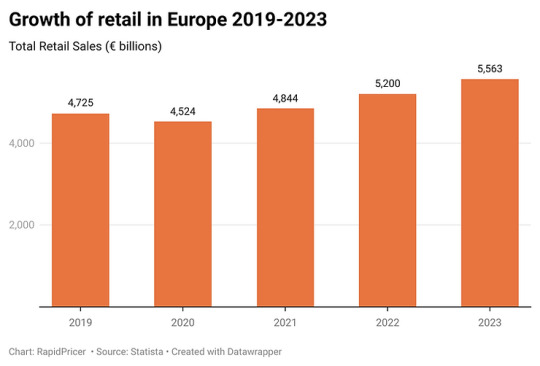
Figure: Growth of retail in Europe
The retail sector in Europe is facing a number of challenges, including the rise of e-commerce, the changing demographics of consumers, and the increasing adoption of new technologies. The rise of e-commerce is one of the most significant challenges facing the retail sector in Europe. In 2021, online retail sales in Europe reached €768 billion, accounting for 16.1% of total retail sales. This growth is being driven by a number of factors, including the increasing availability of high-speed internet, the growing popularity of mobile shopping, and the convenience of online shopping.
Traditional brick-and-mortar retailers are struggling to compete with the convenience and lower prices of online retailers. In order to survive, traditional retailers are investing in their online presence and offering omnichannel experiences that allow customers to shop online and in-store. The demographics of European consumers are also changing, which is having an impact on the retail landscape. The population is aging, with more people over the age of 65. This group is increasingly active and affluent, and they are looking for different products and services than younger consumers. They are also more likely to shop online.
Another demographic trend is the increasing diversity of the European population. This is leading to a demand for more ethnic food and clothing stores. Retailers are also adapting their marketing and advertising to reach these new customer groups.
New technologies are also having a major impact on the retail landscape. The use of artificial intelligence (AI), augmented reality (AR), and virtual reality (VR) is growing, and these technologies are being used to improve the customer experience in a number of ways. For example, AI can be used to personalize recommendations, AR can be used to try on clothes virtually, and VR can be used to create immersive shopping experiences. The adoption of new technologies is also creating new opportunities for retailers. For example, retailers can use data analytics to track customer behavior and improve their marketing and product offerings. They can also use social media to connect with customers and build relationships.
The future of European retail is uncertain, but it is clear that the industry is undergoing a major transformation. The rise of e-commerce, the changing demographics of consumers, and the increasing adoption of new technologies are all having a major impact on the way people shop. Retailers that are able to adapt to these changes will be the ones that are successful in the future.
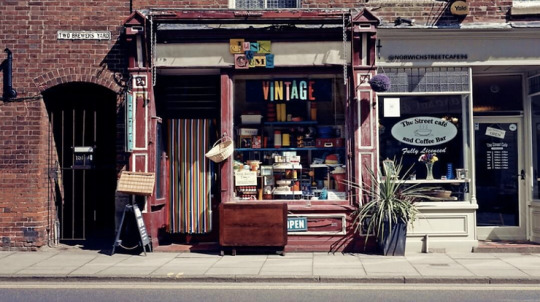
Figure: Brick-and-Mortar stores
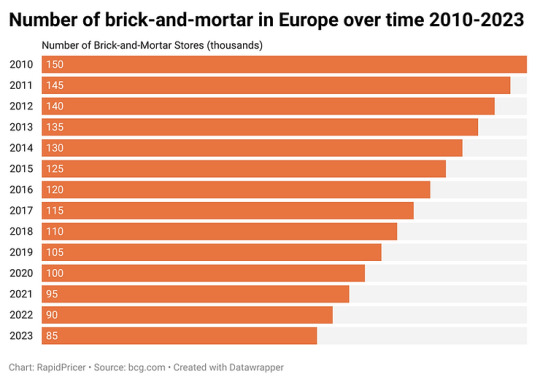
Figure: Number of brick-and-mortar in Europe over time
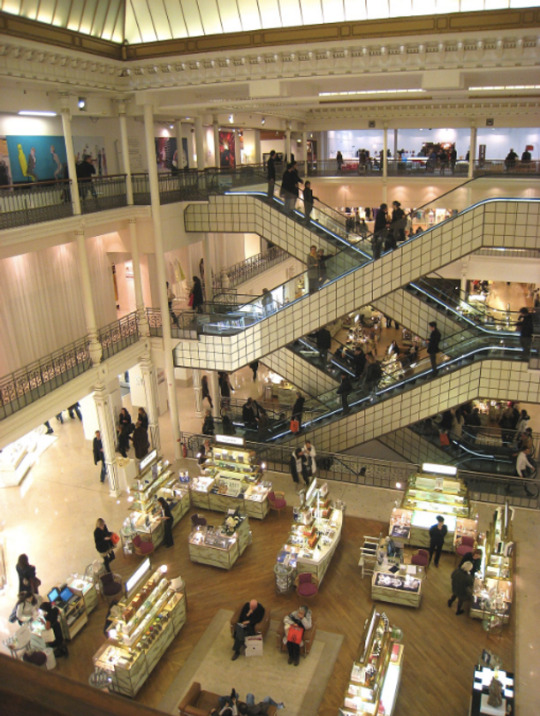
Figure: Department stores
Department stores: Department stores are large stores that sell a variety of products, such as clothing, home goods, and electronics. Some of the most famous department stores in Europe include Galeries Lafayette in Paris, Selfridges in London, and El Corte Inglés in Madrid.
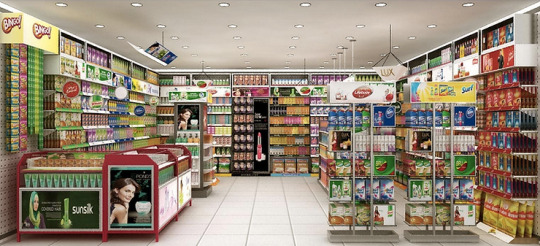
Figure: Independent retailers
Independent retailers: Independent retailers are small, privately owned businesses that sell a variety of products. These retailers often have a strong local presence and offer a unique shopping experience.
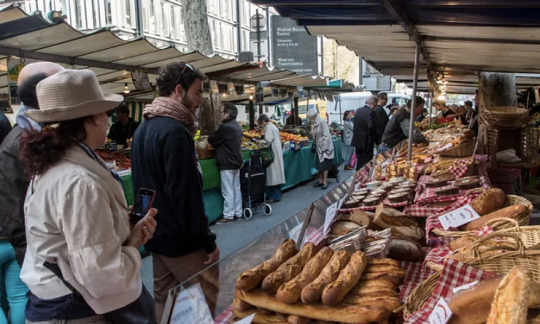
Figure: Markets
Markets: Markets are a great place to find fresh produce, meats, cheeses, and other local products. Many European cities have traditional markets that have been operating for centuries.
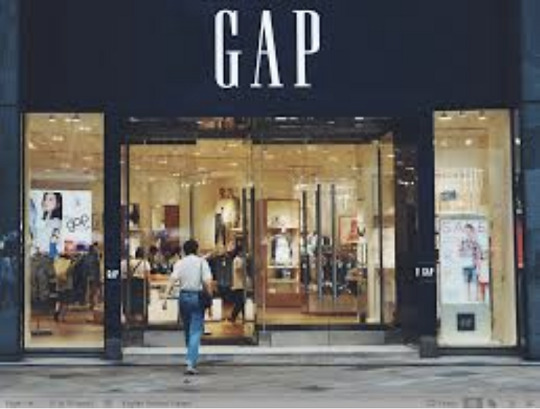
Figure: Outlet
Outlet malls: Outlet malls are a great place to find discounted name-brand clothing, shoes, and accessories. These malls are often located in tourist destinations.
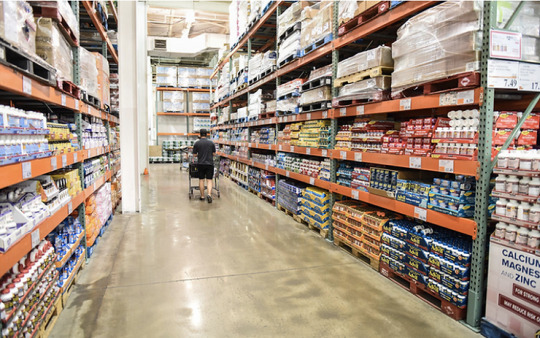
Figure: Warehouse clubs
Warehouse clubs: Warehouse clubs are membership-only stores that sell a variety of products in bulk. These clubs are a great place to find discounts on groceries, household goods, and other items.
Traditional retail is still a major part of the retail landscape in Europe, and it is likely to remain so for the foreseeable future. These stores offer a unique shopping experience that cannot be replicated online. In addition, many traditional retailers are adapting to the changing retail landscape by investing in their online presence and offering omnichannel shopping experiences.
The European Retail Landscape
Europe boasts a diverse and rich retail heritage, with traditional shops, boutiques, and markets dating back centuries. These establishments have played a significant role in local economies, offering consumers a wide range of goods and personalized shopping experiences.
Challenges in the Digital Age: Traditional retail in Europe has felt the impact of the digital age. The rapid growth of e-commerce giants like Amazon, along with the convenience of online shopping, has led to a decline in foot traffic at brick-and-mortar stores. Consumers now have access to a vast array of products with the click of a button, making it essential for traditional retailers to adapt.
The Omnichannel Approach: Many traditional European retailers are responding to the digital challenge by adopting an omnichannel approach. This strategy combines physical stores with an online presence, offering consumers a seamless shopping experience. Retailers are investing in e-commerce websites, mobile apps, and in-store technology to bridge the gap between offline and online shopping.
Customer Experience and Personalization: One advantage traditional retailers have over e-commerce is the ability to provide a unique and personalized customer experience. Many European consumers still value the tactile, sensory experience of shopping in a physical store. Traditional retailers are focusing on creating welcoming and interactive environments, offering personalized service, and curating their product selections to cater to local tastes.
Sustainability and Localism: In response to consumer demand for sustainability and ethical shopping, traditional European retailers are emphasizing their commitment to local sourcing and environmentally friendly practices. Some are rediscovering the benefits of locally-produced goods, promoting them as eco-friendly alternatives to mass-produced items. This aligns with the rising trend of supporting local businesses and reducing the carbon footprint associated with global supply chains.
Cultural and Historical Significance: Traditional retail establishments often hold cultural and historical significance in European communities. Many have been in operation for generations, serving as cornerstones of local culture. These stores are cherished by residents and tourists alike, and efforts are made to preserve their historical authenticity while integrating modern retail practices.
Government Support: Some European governments recognize the importance of preserving traditional retail and are offering support through grants, subsidies, and regulatory measures. These initiatives aim to bolster traditional retail against the encroachment of e-commerce and maintain the vibrancy of city centers.
Conclusion
Traditional retail in Europe is at a crossroads. While it faces challenges from the digital age and changing consumer preferences, it also has unique advantages rooted in history, culture, and personalized shopping experiences. To thrive in today's retail landscape, traditional retailers must embrace technology, adopt an omnichannel approach, focus on customer experience, and align with sustainability and localism trends. In doing so, traditional European retail can not only survive but also continue to offer consumers a distinctive and cherished shopping experience that reflects the rich tapestry of Europe's retail heritage. By adapting to the evolving market while preserving their unique qualities, traditional retailers can continue to play a vital role in the continent's commercial landscape.
The changing demographics of consumers
The demographics of European consumers are also changing, which is having an impact on the retail landscape. The population is aging, with more people over the age of 65. This group is increasingly active and affluent, and they are looking for different products and services than younger consumers. They are also more likely to shop online.
Another demographic trend is the increasing diversity of the European population. This is leading to a demand for more ethnic food and clothing stores. Retailers are also adapting their marketing and advertising to reach these new customer groups.
Here are some specific examples of how the changing demographics of consumers are impacting the retail industry in Europe:
The aging population is leading to a demand for more accessible and convenient shopping options. This is driving the growth of online grocery delivery and click-and-collect services.
The increasing diversity of the population is leading to a demand for more ethnic food and clothing stores. This is also leading to a demand for products and services that cater to the needs of diverse cultures, such as halal food and bilingual customer service.
The rise of the digital native is leading to a demand for more personalized and engaging shopping experiences. This is driving the growth of mobile commerce and augmented reality (AR) shopping.
The changing role of women is leading to a demand for more flexible shopping hours and options for online shopping. This is also leading to a demand for more products and services that are designed for women, such as maternity clothing and baby products.
The growing importance of sustainability is leading to a demand for more sustainable products and services. This is driving the growth of organic food, fair trade clothing, and recycled packaging.
The increasing adoption of new technologies
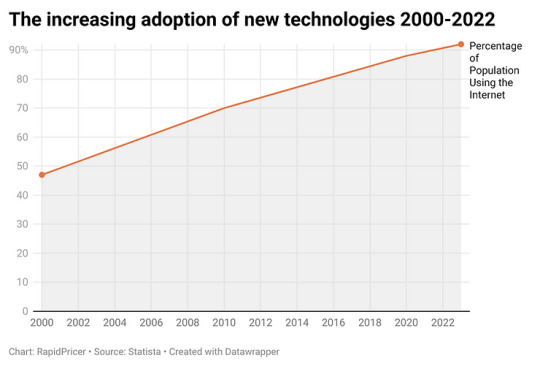
Figure: The increasing adoption of new technologies
As you can see, the percentage of people in Europe using the internet has been increasing steadily over the past two decades. This is due to a number of factors, including the increasing availability of high-speed internet, the falling cost of computers and smartphones, and the growing popularity of online services.
The increasing adoption of new technologies is having a major impact on the retail industry in Europe. Here are some of the key technologies that are being adopted by retailers in Europe:
Artificial intelligence (AI): AI is being used to improve a variety of tasks in the retail industry, such as customer service, inventory management, and fraud detection. For example, AI can be used to analyze customer data to personalize recommendations, or to predict which products are likely to be in high demand.
Augmented reality (AR): AR is being used to create immersive shopping experiences that allow customers to try on clothes virtually or see how furniture would look in their home. For example, IKEA has an AR app that allows customers to see how its furniture would look in their living room.
Virtual reality (VR): VR is being used to create even more immersive shopping experiences that allow customers to virtually visit stores and try on products. For example, Amazon has a VR store that allows customers to browse its products and make purchases.
Internet of Things (IoT): IoT is being used to connect devices and collect data about customer behavior. This data can be used to improve a variety of tasks, such as inventory management and customer service. For example, retailers can use IoT sensors to track the movement of products in stores and to identify when products are running low.
Blockchain: Blockchain is being used to create secure and transparent supply chains. This can help retailers to ensure the authenticity of their products and to track their products from the source to the customer. For example, Walmart is using blockchain to track the supply chain of its food products.
These are just some of the key technologies that are being adopted by retailers in Europe. The adoption of these technologies is helping retailers to improve their efficiency, personalize the customer experience, and create a more sustainable supply chain.
E-Commerce Dominance
One of the most profound shifts in European retail has been the rise of e-commerce. Consumers now have the convenience of shopping online from the comfort of their homes, and this trend has been accelerated by the COVID-19 pandemic. Major players like Amazon, Alibaba, and local champions such as Zalando and ASOS have expanded their reach across Europe, reshaping consumer behavior and expectations. Retailers have had to invest heavily in their online presence, enhancing websites, mobile apps, and supply chain logistics to meet the demand for digital shopping. Additionally, omnichannel strategies have become essential, allowing consumers to seamlessly switch between online and offline shopping experiences.
E-commerce dominance refers to the growing market share of online retailers over traditional brick-and-mortar stores. This trend is being driven by a number of factors, including the increasing availability of high-speed internet, the growing popularity of mobile shopping, and the convenience of online shopping. In Europe, e-commerce sales are expected to reach €768 billion in 2022, accounting for 16.1% of total retail sales. This growth is being driven by the increasing adoption of online shopping by consumers across all demographics.
There are a number of reasons why e-commerce is becoming so dominant. First, the availability of high-speed internet has made it possible for consumers to shop online quickly and easily. Second, the popularity of mobile shopping has made it possible for consumers to shop online from anywhere. Third, the convenience of online shopping is unmatched by traditional brick-and-mortar stores. Consumers can shop online 24/7, compare prices from different retailers, and have products delivered to their door. The rise of e-commerce is having a major impact on the retail industry. Traditional brick-and-mortar stores are facing increasing competition from online retailers, and many are struggling to compete. In order to survive, traditional retailers need to adapt to the changing retail landscape by investing in their online presence and offering omnichannel shopping experiences.

Figure: Share of online retail sales in Europe over time
As you can see, the share of online retail sales in Europe has been increasing steadily in recent years. This is due to the increasing popularity of online shopping, which is more convenient and offers a wider selection of products. The share of online retail sales is expected to continue to increase in the coming years. However, it is important to note that not all countries are affected equally. For example, the share of online retail sales is higher in Northern Europe than in Southern Europe. The future of online retail in Europe is bright. The growth of online shopping is being driven by a number of factors, including the increasing availability of high-speed internet, the growing popularity of smartphones and tablets, and the increasing convenience of online shopping.
Sustainability and Ethical Consumption
The European retail landscape is witnessing a significant shift towards sustainability and ethical consumption. Consumers are becoming increasingly aware of the environmental and social impact of their purchases. Retailers are responding by adopting eco-friendly practices, sourcing sustainable products, and promoting transparency in their supply chains.
Fashion brands, in particular, have made strides in sustainable fashion, with initiatives like "slow fashion" and clothing rental services gaining popularity. European consumers are favoring products that are produced responsibly and have a lower environmental footprint, and retailers are aligning their strategies with these values.
Personalization and Data Analytics
Data analytics and artificial intelligence are playing a crucial role in the transformation of European retail. Retailers are harnessing the power of big data to gain insights into consumer behavior, preferences, and shopping habits. This data-driven approach allows them to personalize marketing efforts, optimize inventory management, and enhance the overall shopping experience.
Personalized recommendations, targeted advertising, and tailored promotions are becoming the norm in the industry. Retailers are using predictive analytics to forecast trends and adjust their product offerings accordingly, ensuring they stay ahead of consumer demands.
Pop-Up Stores and Experiential Retail
While online shopping continues to grow, physical stores are not becoming obsolete. Instead, retailers are reimagining the in-store experience to attract and engage customers. Pop-up stores and experiential retail spaces are gaining popularity, offering unique and immersive experiences that cannot be replicated online.
These temporary stores allow retailers to test new products and connect with customers on a more personal level. They often incorporate interactive elements, such as virtual reality experiences or live demonstrations, to create memorable moments for shoppers.
Cross-Border Expansion
European retailers are increasingly looking beyond their home markets for growth opportunities. Cross-border expansion has become a viable strategy for many companies seeking to tap into new customer bases and diversify revenue streams. The European Union's single market has facilitated this expansion by reducing trade barriers and harmonizing regulations.
Furthermore, technology has made it easier for retailers to reach international customers through e-commerce platforms and digital marketing. As a result, many European brands are expanding their presence into neighboring countries and even outside of Europe, creating a more competitive and globalized retail landscape.
Post COVID European Retail
The retail industry in Europe is undergoing a period of change after COVID. The pandemic has accelerated the shift to online shopping, and brick-and-mortar stores are struggling to compete. Retailers are responding by adopting new technologies, such as AR and VR, and by offering more convenient shopping experiences, such as BOPIS. The industry is also focusing on sustainability, as consumers are increasingly demanding sustainable products and services.
Conclusion
The changing landscape of European retail is characterized by the rapid growth of e-commerce, a focus on sustainability and ethical consumption, data-driven personalization, experiential in-store experiences, and cross-border expansion. Retailers that adapt to these trends and embrace digital transformation are likely to thrive in this dynamic environment.
The future of European retail will continue to be shaped by evolving consumer preferences and technological innovations. To stay relevant, retailers must remain agile, customer-centric, and committed to ethical and sustainable practices. As the industry continues to evolve, it will be exciting to see how retailers innovate and compete in this ever-changing landscape.
About RapidPricer
RapidPricer helps automate pricing, promotions and assortment for retailers. The company has capabilities in retail pricing, artificial intelligence and deep learning to compute merchandising actions for real-time execution in a retail environment.
Contact info:
Website: https://www.rapidpricer.com/
LinkedIn: https://www.linkedin.com/company/rapidpricer/
Email: [email protected]
#European Retail Industry#Retail Trends in Europe#E-commerce Growth#Brick-and-Mortar Stores#Omnichannel Retailing#Digital Transformation#Consumer Behavior#Sustainability in Retail#Retail Technology#Online Marketplaces#Supply Chain Disruptions#Post-Pandemic Retail#Retail Innovation#Mobile Shopping#Data Analytics in Retail#Cross-Border Shopping#Pop-Up Stores#Customer Experience#Retail Competition#Retailer Partnerships#Retail Regulations#Future of Retail in Europe#Retail Challenges#Local vs. Global Retailers#Retail Adaptation Strategies
0 notes
Text
How Archer-Daniels-Midland Company is Shaping the Future of the Smart Food Market: Strategies and Innovations

Introduction:
Archer-Daniels-Midland Company (ADM) stands as a titan in the global food and agribusiness sector, renowned for its extensive portfolio of ingredients, technologies, and solutions. As the smart food market undergoes rapid transformation, ADM is at the forefront, leveraging its expertise and resources to drive innovation and growth.
This article delves into the strategies, emerging innovations, and recent developments by ADM that are shaping the future of the Smart Food Market.
Download FREE Sample: https://www.nextmsc.com/smart-food-market/request-sample
1. Embracing Technology for Enhanced Food Solutions
ADM's strategy for advancing in the smart food market revolves around integrating cutting-edge technology into its operations and product offerings. The company has heavily invested in digital technologies and data analytics to optimize food production and enhance product quality.
AI and Machine Learning: ADM is leveraging artificial intelligence (AI) and machine learning to improve food processing efficiency and product development. By analyzing vast datasets, ADM's AI systems can predict trends, optimize ingredient blends, and ensure consistent product quality. This technological integration not only streamlines operations but also supports the creation of innovative food solutions tailored to consumer demands.
Blockchain for Transparency: In response to growing consumer demand for transparency and traceability, ADM has implemented blockchain technology in its supply chain operations. Blockchain provides a secure and transparent record of each step in the food production process, from farm to table. This technology enhances food safety, reduces fraud, and builds consumer trust by ensuring that products are authentic and sustainably sourced.
2. Focus on Sustainable and Health-Conscious Solutions
Sustainability and health are pivotal themes in ADM's strategy as it adapts to the evolving smart food market. The company is committed to developing products and processes that align with environmental and health-conscious trends.
Sustainable Sourcing and Processing: ADM has made significant strides in sustainable sourcing and processing. The company emphasizes reducing its carbon footprint and minimizing waste through initiatives such as energy-efficient processing technologies and sustainable agricultural practices. By focusing on eco-friendly solutions, ADM aims to meet the growing consumer demand for sustainable and responsibly produced food products.
Health and Wellness Innovations: ADM's innovation strategy includes developing health-focused ingredients and solutions that cater to the rising consumer interest in wellness. The company is investing in research and development to create functional ingredients that offer health benefits beyond basic nutrition. This includes probiotics, plant-based proteins, and nutrient-rich additives designed to support overall well-being and address specific dietary needs.
3. Expanding Product Offerings and Market Reach
ADM's approach to expanding its product offerings and market reach is integral to its strategy in the smart food market. The company is continually diversifying its product portfolio and exploring new market opportunities.
Product Innovation: ADM is actively involved in innovating new food and ingredient products that align with current consumer trends. This includes developing smart food products that incorporate advanced nutritional benefits, such as fortified snacks and functional beverages. By staying ahead of market trends, ADM ensures that its product offerings remain relevant and competitive.
Global Expansion: To capitalize on emerging markets, ADM is expanding its global footprint. The company is entering new regions and strengthening its presence in existing markets through strategic acquisitions and partnerships. This global expansion allows ADM to leverage regional trends, access new consumer bases, and enhance its overall market position.
4. Strategic Partnerships and Collaborations
Strategic partnerships and collaborations are key elements of ADM's strategy to drive growth and innovation in the smart food market. The company actively seeks alliances with other industry leaders, technology providers, and research institutions to accelerate its development efforts.
Collaborations with Startups: ADM is engaging with startups and emerging companies that offer innovative technologies and solutions. These collaborations enable ADM to access new technologies, explore novel product concepts, and accelerate the commercialization of cutting-edge food solutions. By partnering with startups, ADM fosters a culture of innovation and stays at the forefront of industry advancements.
Academic and Research Partnerships: ADM also collaborates with academic institutions and research organizations to advance food science and technology. These partnerships facilitate joint research projects, knowledge exchange, and the development of new technologies and products. Through these collaborations, ADM contributes to advancing the scientific understanding of food and nutrition while benefiting from the latest research insights.
5. Enhancing Consumer Engagement and Digital Presence
In line with its strategy to meet evolving consumer expectations, ADM is enhancing its digital presence and consumer engagement efforts. The company recognizes the importance of connecting with consumers and providing them with relevant information and solutions.
Digital Platforms and Services: ADM is investing in digital platforms that offer consumers easy access to information about its products and services. This includes online tools, mobile apps, and e-commerce platforms that facilitate product discovery, purchase, and engagement. By enhancing its digital presence, ADM aims to improve consumer experiences and drive brand loyalty.
Educational Initiatives: ADM is also focused on educating consumers about the benefits of its smart food products. The company engages in educational campaigns and provides resources that inform consumers about the nutritional value and health benefits of its offerings. This approach helps build trust and fosters informed decision-making among consumers.
Conclusion
Archer-Daniels-Midland Company is strategically positioned to shape the future of the smart food market through its emphasis on technology, sustainability, innovation, and consumer engagement. By embracing cutting-edge technologies, focusing on health and wellness, expanding its product offerings, forging strategic partnerships, and enhancing digital engagement, ADM is driving significant advancements in the food industry.
As ADM continues to innovate and adapt to emerging trends, it will play a crucial role in defining the smart food market's trajectory. The company's commitment to leveraging technology, sustainability, and consumer insights underscores its dedication to shaping a healthier and more sustainable future for food.
#smart food market#food and beverage#retail#consumer trends#market research#industry analysis#innovation
0 notes
Photo

The future of the wellness industry is shifting, and the introduction of hyper-personal, AI technology is transforming its already vast potential further. As businesses of all sizes venture into new realms of data-driven service, the access to health-related information has become a commodity of extraordinary value. Through its algorithms, data science and predictive modelling, this technology is delivering a high level of hyper-personal service, with tailor-made solutions for individual health needs. By capitalizing on the power of artificial intelligence, the industry can unlock more expansive opportunities across the health care sector, while also providing new ways to navigate and capitalize on the US$1.5 trillion market. The possibilities are endless, and the future of the wellness industry will be determined by the innovation of AI.
#Artificial Intelligence#Community#Consumer#Retail#Singapore#fault#AI#hyper-personal#wellness industry#personalized#predictive
0 notes
Text
#INDUSTRIES#3E-Retail#3E-Financial Services#3E-Banking#3E-Consumer Lending#3E-Retail Financing#3E-Technology#3E-Data Analysis#3E-Marketing#3E-Advertising.#VALUES#3E-Transparency#3E-Responsibility#3E-Honesty#3E-Integrity#3E-Fairness#3E-Accountability#3E-Trustworthiness#TRAITS#3E-Financial Management#3E-Advocate for Financial Freedom#3E-Risk Management#3E-Resource Management#3E-Savvy#3E-Openness to Change#3E-Growth Mindset.#TENSIONS#3E-Implications of the generational differences on debt and financial literacy#3E-Concerns about the impacts of encouraging young generations to incur debt
0 notes
Text
The local population in countries that export bananas typically eat different varieties grown primarily by small farmers. The ones for the Americans and the Europeans, Cavendish variety bananas, are grown in huge, monoculture plantations that are susceptible to disease. The banana industry consumes more agrichemicals than any other in the world, asides from cotton. Most plantations will spend more on pesticides than on wages. Pesticides are sprayed by plane, 85% of which does not land on the bananas and instead lands on the homes of workers in the surrounding area and seeps into the groundwater. The results are cancers, stillbirths, and dead rivers.
The supermarkets dominate the banana trade and force the price of bananas down. Plantations resolve this issue by intensifying and degrading working conditions. Banana workers will work for up to 14 hours a day in tropical heat, without overtime pay, for 6 days a week. Their wages will not cover their cost of housing, food, and education for their children. On most plantations independent trade unions are, of course, suppressed. Contracts are insecure, or workers are hired through intermediaries, and troublemakers are not invited back.
Who benefits most from this arrangement? The export value of bananas is worth $8bn - the retail value of these bananas is worth $25bn. Here's a breakdown of who gets what from the sale of banana in the EU.
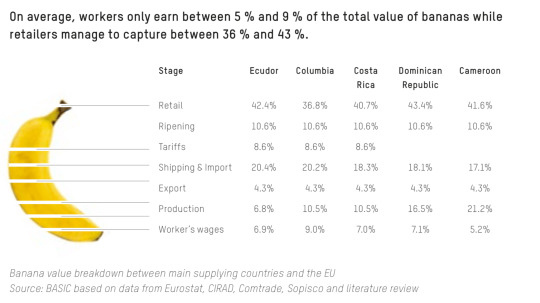
On average, the banana workers get between 5 and 9% of the total value, while the retailers capture between 36 to 43% of the value. So if you got a bunch of bananas at Tesco (the majority of UK bananas come from Costa Rica) for 95p, 6.65p would go to the banana workers, and 38p would go to Tesco.
Furthermore, when it comes to calculating a country's GDP (the total sum of the value of economic activity going on in a country, which is used to measure how rich or poor a country is, how fast its economy is 'growing' and therefore how valuable their currency is on the world market, how valuable its government bonds, its claim on resources internationally…etc), the worker wages, production, export numbers count towards the country producing the banana, while retail, ripening, tariffs, and shipping & import will count towards the importing country. A country like Costa Rica will participate has to participate in this arrangement as it needs ‘hard’ (i.e. Western) currencies in order to import essential commodities on the world market.
So for the example above of a bunch of Costa Rican bananas sold in a UK supermarket, 20.7p will be added to Costa Rica’s GDP while 74.3p will be added to the UK’s GDP. Therefore, the consumption of a banana in the UK will add more to the UK’s wealth than growing it will to Costa Rica’s. The same holds for Bangladeshi t-shirts, iPhones assembled in China, chocolate made with cocoa from Ghana…it’s the heart of how the capitalism of the ‘developed’ economy functions. Never ending consumption to fuel the appearance of wealth, fuelled by the exploitation of both land and people in the global south.
7K notes
·
View notes
Text
if you haven’t at least tried sewing or crocheting or knitting your own clothes, you really should. even if it’s just one time and you never do it again, i really think everyone should do it at least once
learning how to crochet was what finally made me grasp the abject horror of the fast fashion industry and realize just how laborious and time consuming it is. i have to take a few days off a week so my back/wrists don’t get sore — and i get to do this as a leisure activity in the comfort of my own home, rather than in a sweatshop. it takes dozens of hours to produce a single item. there is just something about trying it yourself that makes you realize just how little the people making our clothes are being paid for retailers to be able to sell clothes at such obscenely low prices.
i understood in the abstract that people were earning literal slave wages to make my clothes, but that concept wasn’t real to me in a way i could understand until i spent 14 hours making something that i myself wouldn’t have even been willing to pay more than $10-20 for if i saw it in a store.
i have not bought any new clothes since learning how to crochet. every time i see clothes at a store (especially obviously handmade items like crochet), and i look at the price tag i feel genuinely sick to my stomach.
i’m not saying everyone needs to make their own clothes in order to be against fast fashion, but what i am saying is if hearing about the conditions and wages secondhand has not been enough to make you stop buying it, if you find yourself becoming desensitized to the suffering of the people who make your things, you should try making something yourself.
you need to see firsthand how physically and mentally demanding it can be and imagine how much worse it would be if you were forced to sit in a sweatshop for 16 hours a day doing it nonstop, earning pennies an hour to do so. you need to spend weeks laboring over something only for it to turn out looking like shit so you realize just how much wisdom and technical skill goes into these supposedly “unskilled” and undervalued jobs. if the abstract concept isn’t enough to get through to you, then you need to get hands on.
#abolish fast fashion#fast fashion#shein#temu#h&m#sustainability#sustainable fashion#sustainable living#diy fashion#sewing#knitting#crochet#anti consumerism#anti capitalism#working class solidarity#sweatshops#ethical fashion#labor rights#star’s posts
1K notes
·
View notes